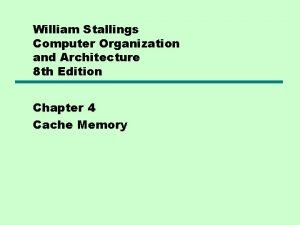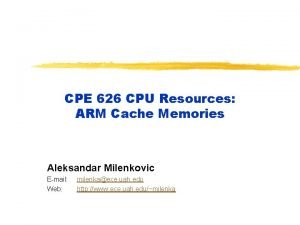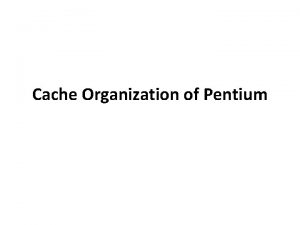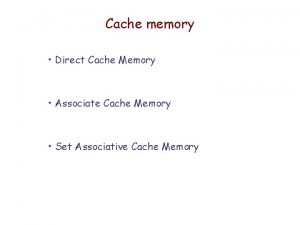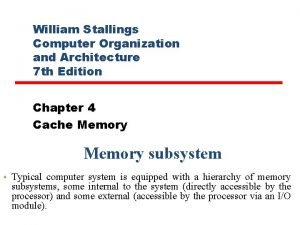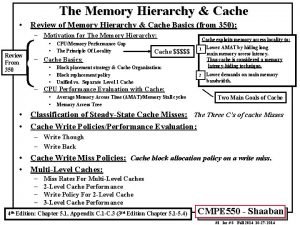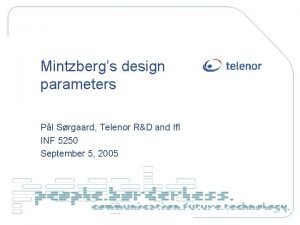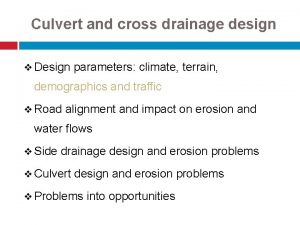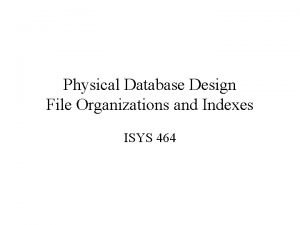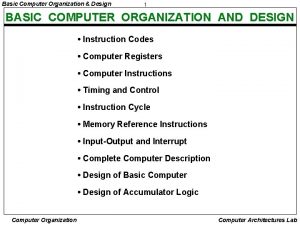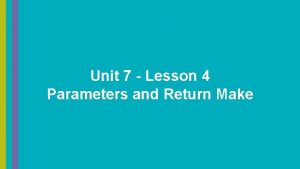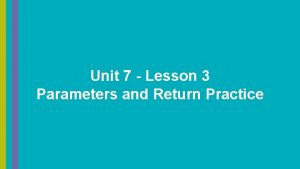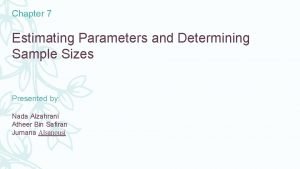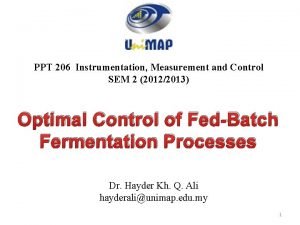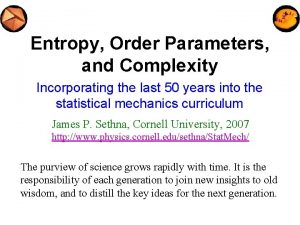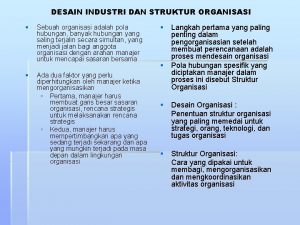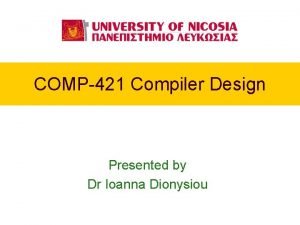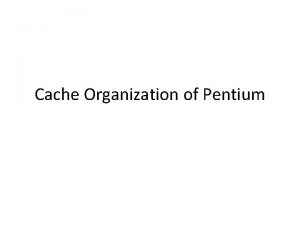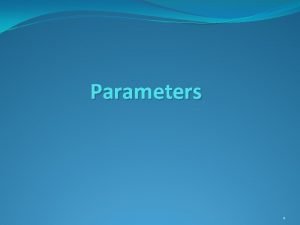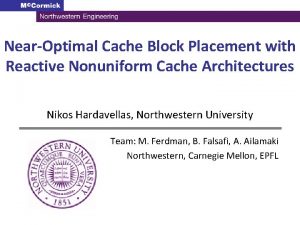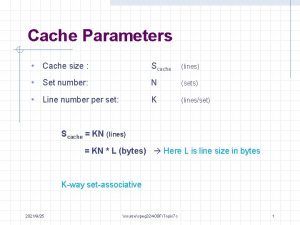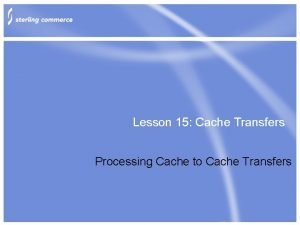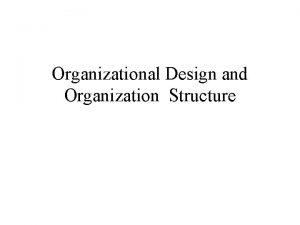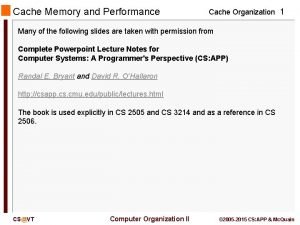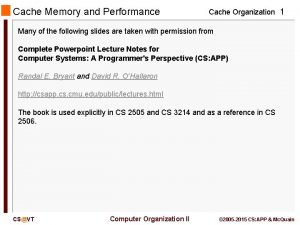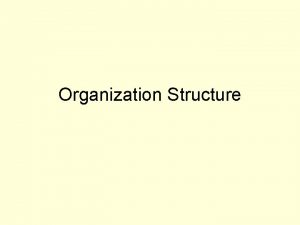Cache Design Cache parameters organization and placement Cache




















![A B C D E F G H [a] Nearest Future Access Furthest Future A B C D E F G H [a] Nearest Future Access Furthest Future](https://slidetodoc.com/presentation_image_h2/f6192ce861c7470c4660617acbad4efa/image-21.jpg)













- Slides: 34

Cache Design • Cache parameters (organization and placement) • Cache replacement policy • Cache performance evaluation method 2021/10/29 coursecpeg 324 -05 FTopic 7 c 1

Cache Parameters • Cache size : Scache (lines) • Set number: N (sets) • Line number per set: K (lines/set) Scache = KN (lines) = KN * L (bytes) --- here L is line size in bytes K-way set-associative 2021/10/29 coursecpeg 324 -05 FTopic 7 c 2

Trade-offs in Set-Associativity Full-associative: Higher hit ratio, concurrent search, but slow access when associativity is large; Direct mapping: fast access (if hits) and simplicity for comparison trivial replacement alg. Also, if alternatively use 2 blocks which mapped into the same cache block frame: “trash” may happen. 2021/10/29 coursecpeg 324 -05 FTopic 7 c 3

Note • Main memory size: Smain (blocks) Cache memory Size: Scache (blocks) Smain Let P = You need search! Scache Since P >>1, average search length is much greater than 1. • Set-associativity provides a trade-off between 2021/10/29 - concurrency in search - average search/access time per block coursecpeg 324 -05 FTopic 7 c 4

Set # 1 Full associative 2021/10/29 < N < Set associative coursecpeg 324 -05 FTopic 7 c Scache Direct Mapped 5

Important Factors in Cache Design • Address partitioning strategy (3 -dimention freedom) • Total cache size/memory size • Work load 2021/10/29 coursecpeg 324 -05 FTopic 7 c 6

Address Partitioning M bits Log N Set number Log L address in a line • Byte addressing mode • • 2021/10/29 Cache memory size data part = NKL (bytes) Directory size (per entry) M - log 2 N - log 2 L Reduce clustering (randomize accesses) coursecpeg 324 -05 FTopic 7 c set size 7

Note: The exists a knee 1. 0 0. 9 Miss Ratio 0. 8 0. 7 0. 6 0. 5 0. 4 0. 3 0. 2 0. 1 8 10 20 30 40 General Curve Describing Cache Behavior 2021/10/29 coursecpeg 324 -05 FTopic 7 c Cache Size 8

…the data are sketchy and highly dependent on the method of gathering. . . … designer must make critical choices using a combination of “hunches, skills, and experience” as supplement… “a strong intuitive feeling concerning a future event or result. ” 2021/10/29 coursecpeg 324 -05 FTopic 7 c 9

Basic Principle • Typical workload study + intelligent estimate of others • Good Engineering: small degree over-design • “ 30% rule” - Each doubling of the cache size reduces misses by 30% by A. Smith - 2021/10/29 It is a rough estimate only coursecpeg 324 -05 FTopic 7 c 10

Cache Design Process • “Typical”, not “Standard” • “Sensitive” to: - Price-performance -- Technology - main M access time - cache access - chip density - bus speed - on-chip cache 2021/10/29 coursecpeg 324 -05 FTopic 7 c 11

Cache Design Process Choose cache size fix K, L, varying N Use new k Pick k = 2 - (likely k = 1) K is small If k = old 2021/10/29 Choose line size L for fix cache size and K, varying L Choose associativity K fix cache size and L, varying K coursecpeg 324 -05 FTopic 7 c 12

Step 1 : Choose Size fix K, L, varying N 1. 0 Relative Number of Misses 0. 9 0. 8 0. 7 0. 6 0. 5 0. 4 0. 3 0. 2 0. 1 2021/10/29 10 20 Cache Size (N) coursecpeg 324 -05 FTopic 7 c 30 40 13

Step 2 : Choose L fix NKL = size and K, varying L 1. 0 Relative Number of Misses 0. 9 0. 8 0. 7 0. 6 0. 5 0. 4 0. 3 0. 2 0. 1 10 2021/10/29 20 30 Cache Line Size (L) coursecpeg 324 -05 FTopic 7 c 40 14

Step 2 : Choose K fix NKL = size and L, varying K 1. 0 Relative Number of Misses 0. 9 0. 8 0. 7 0. 6 0. 5 0. 4 0. 3 0. 2 0. 1 10 2021/10/29 20 30 Cache Associativity Factor (K) coursecpeg 324 -05 FTopic 7 c 40 15

N: Set number Cache directory# =N K Cache size =N K L Constraints in selection of N: (page size) 2021/10/29 coursecpeg 324 -05 FTopic 7 c 16

K: Associativity • Bigger miss ratio • Smaller is better in: - faster - Cheaper simpler • 4 ~ 8 get best miss ratio 2021/10/29 coursecpeg 324 -05 FTopic 7 c 17

L : Line Size • Atomic unit of transmission • Miss ratio • Smaller - Larger average delay - Less traffic - Larger average hardware cost for associative search - Larger possibility of “Line crossers” • Workload dependent • 16 ~ 128 byte 2021/10/29 coursecpeg 324 -05 FTopic 7 c 18

Cache Replacement Policy • FIFO (first-in-first-out) • LRU (least-recently used) • OPT (furthest-future used) do not retain lines that have next occurrence in the most distant future Note: LRU performance is close to OPT for frequently encountered program structures. 2021/10/29 coursecpeg 324 -05 FTopic 7 c 19

Program Structure i=1 for to n j = 1 to n …. for endfor last-in-first-out feature makes the recent past likes the near future 2021/10/29 coursecpeg 324 -05 FTopic 7 c 20
![A B C D E F G H a Nearest Future Access Furthest Future A B C D E F G H [a] Nearest Future Access Furthest Future](https://slidetodoc.com/presentation_image_h2/f6192ce861c7470c4660617acbad4efa/image-21.jpg)
A B C D E F G H [a] Nearest Future Access Furthest Future Access B C A D E F G H Nearest Future Access Furthest Future Access [b] B Z C A D E F G Nearest Future Access Furthest Future Access [c] An eight-way cache directory maintained with the OPT policy: [a] Initial state for future reference-string AZBZCADEFGH; [b] After the cache hit the Line A; and [c] After the cache miss to Line Z. 2021/10/29 coursecpeg 324 -05 FTopic 7 c 21

Why LRU and OPT are Close to Each Other? LRU : look only at past OPT : look only at future But, recent past ~ ~ nearest future Why? (Consider nested loops) 2021/10/29 coursecpeg 324 -05 FTopic 7 c 22

Problem with LRU • Not good in mimic sequential/cyclic • Example ABCDEF ABC…… With a set size of 3 2021/10/29 coursecpeg 324 -05 FTopic 7 c 23

Sequential Access OPT A B A C D E F G A B C……G ABC…G ABC A B C B C A B A B C B A D C B E D C F E D LRU A 2021/10/29 coursecpeg 324 -05 FTopic 7 c …. . . 24

Empirical Data OPT can gain about 10% ~ 30% improvement over LRU (in terms of miss reduction) 2021/10/29 coursecpeg 324 -05 FTopic 7 c 25

A Comparison • OPT has two candidates for replacement the most recently referenced the furthest to be referenced in the future • LRU only has one - the least-recently used -- it never replaces the most recently referenced deadline in LRU 2021/10/29 coursecpeg 324 -05 FTopic 7 c 26

Performance Evaluation Methods for Workload • Analytical modeling • Simulation • Measuring 2021/10/29 coursecpeg 324 -05 FTopic 7 c 27

Cache Analysis Methods • Hardware monitoring 2021/10/29 - fast and accurate - not fast enough (for high-performance machines) - cost - flexibility/repeatability coursecpeg 324 -05 FTopic 7 c 28

cont’d Cache Analysis Methods • Address traces and machine simulator 2021/10/29 - slow - accuracy/fidelity - cost advantage - flexibility/repeatability - OS/other impacts - how to put them in? coursecpeg 324 -05 FTopic 7 c 29

Trace Driven Simulation for Cache • Workload dependence - difficulty in characterizing the load - no general accepted model • Effectiveness 2021/10/29 - possible simulation for many parameters - repeatability coursecpeg 324 -05 FTopic 7 c 30

Problem in Address Traces • Representative of the actual workload (hard) - only cover milliseconds of real workload - diversity of user programs • Initialization transient - use long enough traces to absorb the impact • Inability to properly model multiprocessor effects 2021/10/29 coursecpeg 324 -05 FTopic 7 c 31

An Example • Assume a two-way associative cache with 256 sets Scache = 2 x 256 lines • Assume that the difficulties of count or not count the initialization causes 512 more misses than actually required • Assume a trace of length 100, 000 with hit rate 0. 99 than 1000 misses is generated the 512 makes big difference!! • If want 512 miss count less than 5% then total misses = 512/5% = 10, 240 miss thus with hit = 0. 99 required trace length > 1, 024, 000! 2021/10/29 coursecpeg 324 -05 FTopic 7 c 32

One may not know the cache parameters before hand What to do? ? Make it longer than minimum acceptable length! 2021/10/29 coursecpeg 324 -05 FTopic 7 c 33

• 100, 000? too small • (10 ~ 100) x 106 OK? • 1000 x 106 or more being used now. . 2021/10/29 coursecpeg 324 -05 FTopic 7 c 34
 Pentium 4 cache organization
Pentium 4 cache organization Arm cache organization
Arm cache organization Explain cache organization of pentium
Explain cache organization of pentium Cache memory organization
Cache memory organization Cache memory organization
Cache memory organization Associative mapping
Associative mapping Three level cache organization
Three level cache organization Mintzberg design parameters
Mintzberg design parameters Esp course design sample
Esp course design sample Dpg spring meeting
Dpg spring meeting Design parameters
Design parameters Block organization essay- examples
Block organization essay- examples Process organization in computer organization
Process organization in computer organization Emphasis/focal point
Emphasis/focal point Digital controller example
Digital controller example Cache memory design
Cache memory design File organization and database design
File organization and database design Flowchart for memory reference instructions
Flowchart for memory reference instructions Interrupt cycle flow chart
Interrupt cycle flow chart Basic computer organization and design
Basic computer organization and design Basic computer design
Basic computer design Lesson 4 parameters and return make rock paper scissors
Lesson 4 parameters and return make rock paper scissors Lesson 3 parameters and return practice 8
Lesson 3 parameters and return practice 8 Common critical values
Common critical values Lesson 3 parameters and return practice 7
Lesson 3 parameters and return practice 7 Extrinsic parameters of food
Extrinsic parameters of food Instrumentation and control systems ppt
Instrumentation and control systems ppt Instrumentation ppt
Instrumentation ppt Entropy order parameters and complexity
Entropy order parameters and complexity Objectives of form design
Objectives of form design Basic forms of organization design
Basic forms of organization design Industrial design organization
Industrial design organization Activation tree for quicksort
Activation tree for quicksort Dimensions of organization design
Dimensions of organization design Dimensions of organization design
Dimensions of organization design
